Uber has revolutionised urban mobility by letting people book on-demand transportation services, including private car rides, scooters, shuttles and food delivery.
According to reports, the app secured $19.6 billion in revenue from its ride sharing segment in 2023. In the same year, Uber's app was used by around 150 million people at least once a month.
But even considering the platform’s popularity, Uber has some downsides your business can take advantage of.
For example, Uber's dynamic pricing model can lead to high fares during peak hours. Secondly, users have raised concerns over a lack of in-built passenger safety features. Competitors can differentiate themselves by tackling these concerns head-on.
In this guide, we'll look at the main features your ride sharingapp needs and explain how you can create one using our platform.
What is a ride sharing app?
Ride sharing apps are digital platforms that connect passengers with drivers. Passengers initiate this process by requesting rides through the app. The app then calculates the best route to their desired destination and provides a fare, before matching passengers to a driver nearby.
Ultimately, ride sharing apps provide a convenient, often cost-effective alternative to traditional taxis and public transportation, enhancing urban mobility.
Ride sharing apps are here to stay
The global ride sharing market is currently valued at approximately $106.66 billion as of 2023, which is expected to grow to $480.09 billion by 2032. These ride sharing apps grow their revenue year-on-year because they offer a convenient, cost-effective and flexible alternative to traditional taxis and public transport.
Moreover, ride sharing apps contribute to reducing traffic congestion and lowering carbon emissions. As urbanisation continues and digital connectivity improves, these platforms cement their role in the urban ecosystem.
Types of ride sharing apps
Let’s delve in deeper to understand different types of ride sharing apps 👇
Peer-to-peer ride sharing
These apps connect drivers with personal vehicles to passengers who need rides. For example, Uber and Lyft offer a range of services from budget-friendly options to luxury rides.
Carpooling services
These services are designed for passengers to share rides on common routes. Apps like Blablacar typically cover longer distances, helping to split travel costs.
On-demand shuttle services
These apps provide shuttle services to passengers with a journey at the desired time from an agreed-upon pickup location. For example, apps like Via and Bridj provide bus rides to multiple passengers heading on the same route.
Corporate carpooling
These platforms target corporates and their employees in sharing rides to and from the workplace. For example, Scoop offers coworkers to carpool together.
Bike and scooter sharing
These apps provide access to bicycles and electric scooters for short, urban trips. Lime and Bird are notable examples, offering a flexible, eco-friendly alternative to motor vehicles.
Luxury car services
These apps offer high-end vehicles for those looking for a more upscale riding experience. For example, Blacklane provides professional chauffeur services with luxury cars for airport transfers and business trips.
Special-needs transportation
Some apps cater specifically to senior citizens or differently abled individuals requiring special transportation arrangements. For example, Access-A-Ride provides door-to-door services for eligible riders.
Rides for children
These apps ensure safe transport for children following specific safety standards and regulations. HopSkipDrive and Zum are services designed to help busy parents get their kids to and from school and activities safely.
Must-have features of ride sharing apps
Ride sharing apps need a range of features to meet user expectations for convenience, safety and efficiency, including…
User profiles
User profiles store preferences, trip history and payment methods, streamlining the booking process for a quick and personalised experience. They also enhance safety by providing verified information about drivers and riders.
GPS and map integration
Real-time tracking features in your app are essential for both drivers and passengers to navigate routes, estimate travel time and track the ride's progress. Also, this feature helps to calculate the fare based on distance.
Ride booking
Users should be able to book a ride immediately or schedule it for later with just a few taps. Additionally, once a ride is booked, passengers should get information about the vehicle, including the driver’s name, photo and licence plate number — improving passenger safety and convenience.
Fare calculator
Before confirming the ride, your users should see an estimated cost based on distance, ride type and surge pricing if applicable.
Multiple payment options
Including various payment methods on your app such as credit/debit cards, mobile wallets and cash ensures security and makes it easy to pay.
Rating and reviews
After the ride, your users should be able to rate their experience and provide feedback. This system helps maintain high service standards and trust within the platform.
Push notifications
Notifications for ride status updates, promotions and other relevant information keep users engaged and informed about the app.
Safety features
Emergency buttons, ride tracking and sharing ride details with trusted contacts should be integrated in the app for the safety of passengers and drivers using your app.
Customer support
Access to customer support to help resolve issues related to rides, payments or disputes is essential. Users should have access to support through various channels like chat, email or phone.
Accessibility features
This ensures that your app is accessible and easy-to-use for people with disabilities, such as those who are visually impaired or have mobility challenges.
Who should you choose to build your ride sharing platform?
There are many ways you can create a ride sharing platform. If you’re a programmer, you could create one yourself, but this might take a while. After all, complex ride sharing apps are made up of hundreds of thousands of lines of code.
Alternatively, you can hire a team of mobile app developers, who can build sophisticated, custom ride sharing software. However, the challenge here is to accurately calculate the total cost of app development.
They often charge on an hourly or daily basis, and once you factor in the costs of app development, design, app testing and listing, your expenses can quickly spiral out of control.
No-code app builders are a simpler, more budget-friendly solution. You don’t need coding skills to use them and you can build apps quickly by dragging and dropping pre-made components.
However, no-code platforms may lack the flexibility to add complex features or unique customisations. Scaling your app as your user base grows may also be challenging due to performance limitations.
This is where Builder.ai comes in 👇
Why Builder.ai is different
Builder.ai bridges the gap between these different app development routes.
Our platform provides the customisation and scalability of professional developers along with the efficiency and cost-effectiveness of no-code builders, making it an ideal choice for developing your ride sharing app.
Around 80% of all software is made up of around 650+ features. We package each basic feature as a reusable Lego-like block. Explain your idea to our AI companion, Natasha, and she uses these blocks to rapidly create an outline of your app.
Because Natasha handles all the repetitive coding, we can complete tasks faster and cheaper. Then it’s off to our app design team and mobile app developers. They personalise it and create any bespoke elements you need.
To build your ride sharing platform, simply head over to Builder Studio. The Builder Studio platform has been built with user convenience in mind and intuitively guides you through the app creation process.
Let’s dive in with the step-by-step process 👇
Want to start your app project with us?
Book a demoSpeak with one of our product experts today.
By proceeding you agree to Builder.ai’s privacy policy and terms and conditions

1 - Discuss your ideas with Natasha
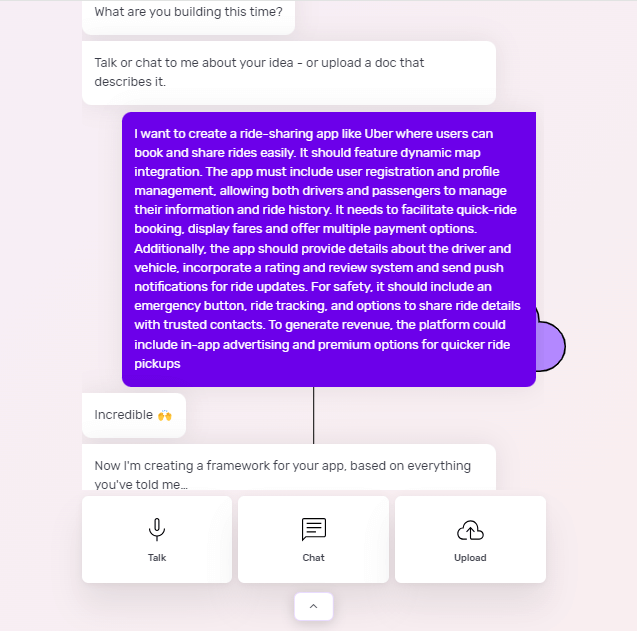
On Builder Studio, you’re greeted by Natasha. You can express your ride sharing app idea to Natasha via voice, text or uploading a PDF or doc file.
Before you chat with her, have a checklist of app features and be as descriptive as possible about your app idea. The more detailed information you give to Natasha, the better her suggestions will be.
For example, a prompt could look like this:
"I want to create a ride sharing app like Uber where users can book and share rides easily. It should feature dynamic map integration. The app must include user registration and profile management, allowing both drivers and passengers to manage their information and ride history.
It needs to facilitate quick-ride booking, display fares and offer multiple payment options. Additionally, the app should provide details about the driver and vehicle, incorporate a rating and review system and send push notifications for ride updates.
For safety, it should include an emergency button, ride tracking, and options to share ride details with trusted contacts. To generate revenue, the platform could include in-app advertising and premium options for quicker ride pickups.”
Based on your prompt, Natasha will ask you some supporting questions and you simply need to answer them based on your requirements.
2 - Choose a base
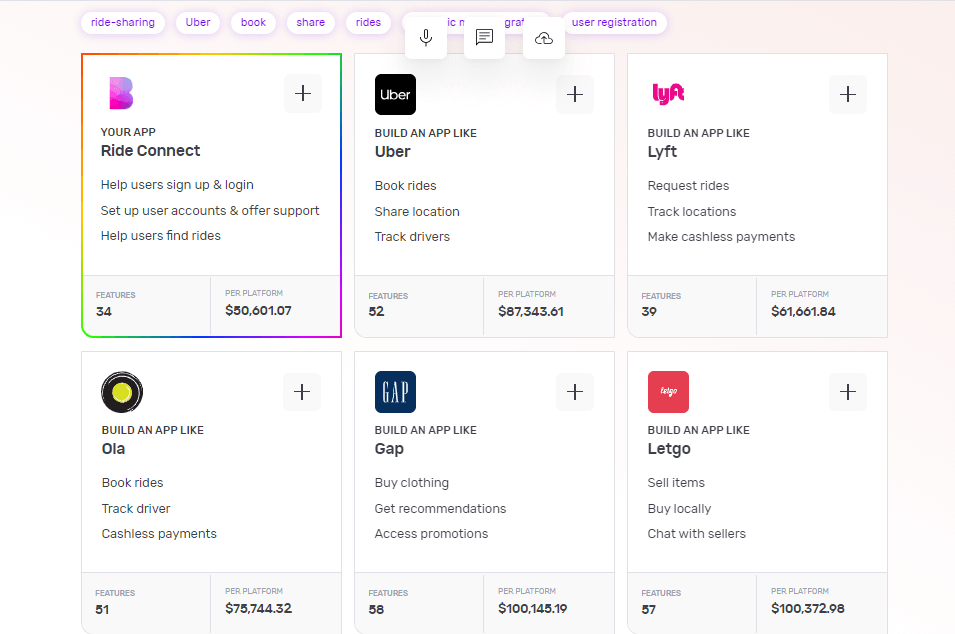
Once Natasha has your requirements, she’ll create a custom framework for your app based on everything you tell her. She'll also suggest some pre-built bases she thinks are best suited for your app.
For instance, once you tell her to create an app like Uber she’ll suggest a custom base similar to Uber and share any matching core bases as well.
You can choose up to 3 you feel are related to your big idea by simply clicking the ‘+’ icon. These selections make it easier for us to understand the features your app needs. When you’re ready, click 'Next'.
3 - Make it mine
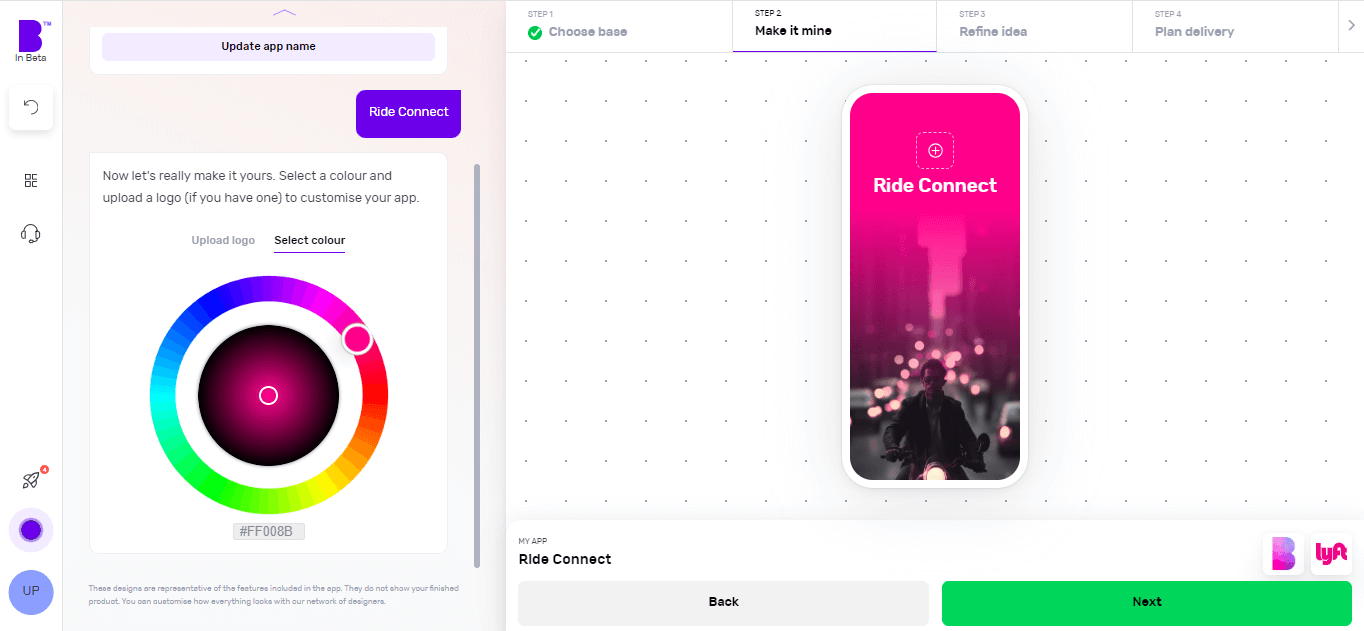
The 'Make it mine' step aligns your app with the identity of your brand. In this step, you choose the name to your app, select its colour scheme using the colour wheel and upload the logo of your brand.
If you already have a website, you can add the link and Builder Studio will automatically pick your brand’s colours and logo.
Once you’ve personalised your app’s name, colour and logo, you can click ‘Next’.
4 - Refine your app idea
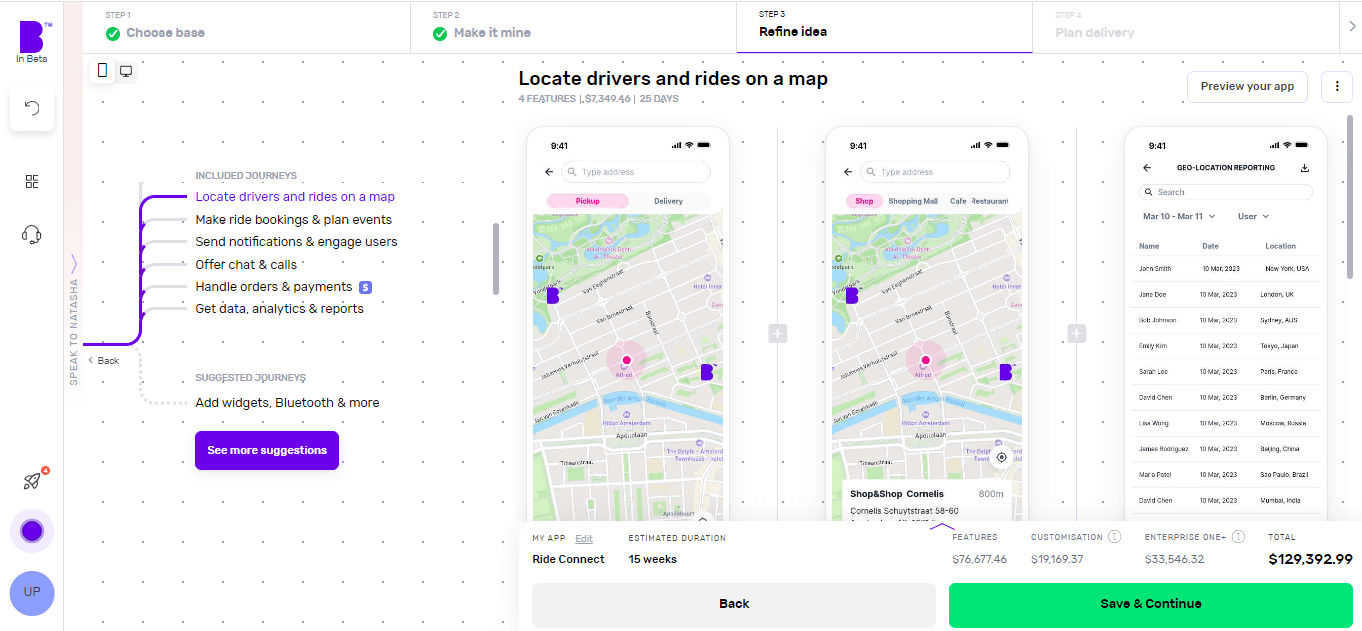
Now comes the fun bit.
In the 'Refine idea' stage, you can review and customise your app journeys and features and also create an instant prototype of your app.
Journeys
In only a matter of seconds, Natasha creates app user journeys with corresponding features.
Go through these journeys carefully and see if your app needs additional journeys. For instance, check if you want to add journeys for monetisation, sending notifications or any other relevant journey.
To add journeys, click on 'See more suggestions'. Doing so will open the list of pre-built journeys. You can browse the list and select the journeys you’re missing. You can also add custom journeys by clicking on 'Add custom journey'.
Features
By clicking on individual journeys, you can see the feature list each journey contains. Doing so will open the feature list each journey contains. You can scroll through the feature list and check if a journey contains non-essential features or if you want to add extra features.
To remove a non-essential feature, you can hover over the feature and click ‘Remove’. This way you can manage project costs. If you’re not sure what features to remove, you can click on an individual feature and check the label at the top. We highly recommend keeping the ‘Essential Features’.
In case you want to add more features, you can simply click the ‘+’ button. Here you can go through different categories or use the search bar to look for missing functionality. In case you don’t find the feature you’re looking for, you can also add a custom feature by clicking on 'Add custom feature'.
Instant prototype and user flow
Once you’re happy with the journeys and features of your app, you can create a prototype by clicking on 'Preview your app' in the top-right corner.
Sign up and Natasha will create a working prototype of your app. You can click on the screen at different areas to progress through the journey.
You can also see the user flow by clicking on the 'Flow mode' at the top of the screen to see how users will interact and navigate within your app.
If you need extra help, Natasha is on hand to help and you can interact with her at any time by clicking on 'Speak to Natasha'.
She’ll provide you with suggestions and help you find features or journeys from the library. Or you can click on 'Book a demo' to talk to our product managers who’ll guide you through your app development journey.
Click on 'Save & Continue' to go to next step.
5 - Plan delivery
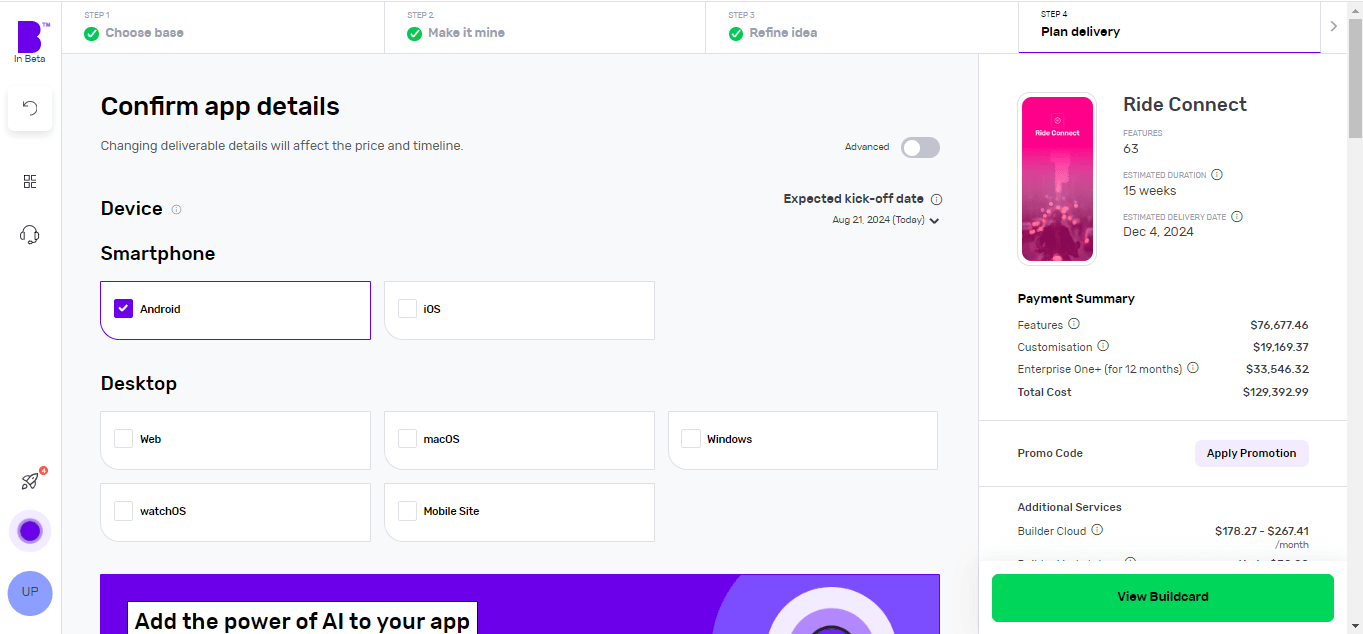
It’s time to choose the platforms you want your ride sharing app to be available on. You can choose Android, iOS or develop for both platforms simultaneously.
Next, you can choose to add Natasha to your platform to supercharge the customer experience of your ride sharing app. Natasha uses Large Language Models (LLMs) to engage your customers in fluid, human-like conversations.
In the development speed section, you can change the speed of each phase according to your needs. The faster the development speed, the higher the costs and vice versa.
Next up is Design. If you have your app designs ready, you can save your costs by clicking 'You have design' and we’ll reduce your costs accordingly. You can share your design files (preferably in Figma) and our designers will upload them, so you can kick off straight away.
If not, you can choose the 'We do your designs'. Here, you simply need to add your brand assets and we'll do everything from storyboarding to fully designed screens.
Now it’s time to plan the phases of your project. Here you get 3 options:
- Clickable prototype: you’ll get a visual representation of your app to test with users
- Basic build: you’ll get an MVP (Minimum viable product) – a hard-coded but simplified version of your idea— this allows you to collect feedback and iterate before you do a full build
- Full Build: you’ll get market-ready software, including a kick-off with our product team and review sessions
After that, you need to select your support plans. With 'Full Build' you get one year of Studio One support included free of charge.
Once you’ve planned your delivery, click on 'View Buildcard'.
6 - Review Buildcard
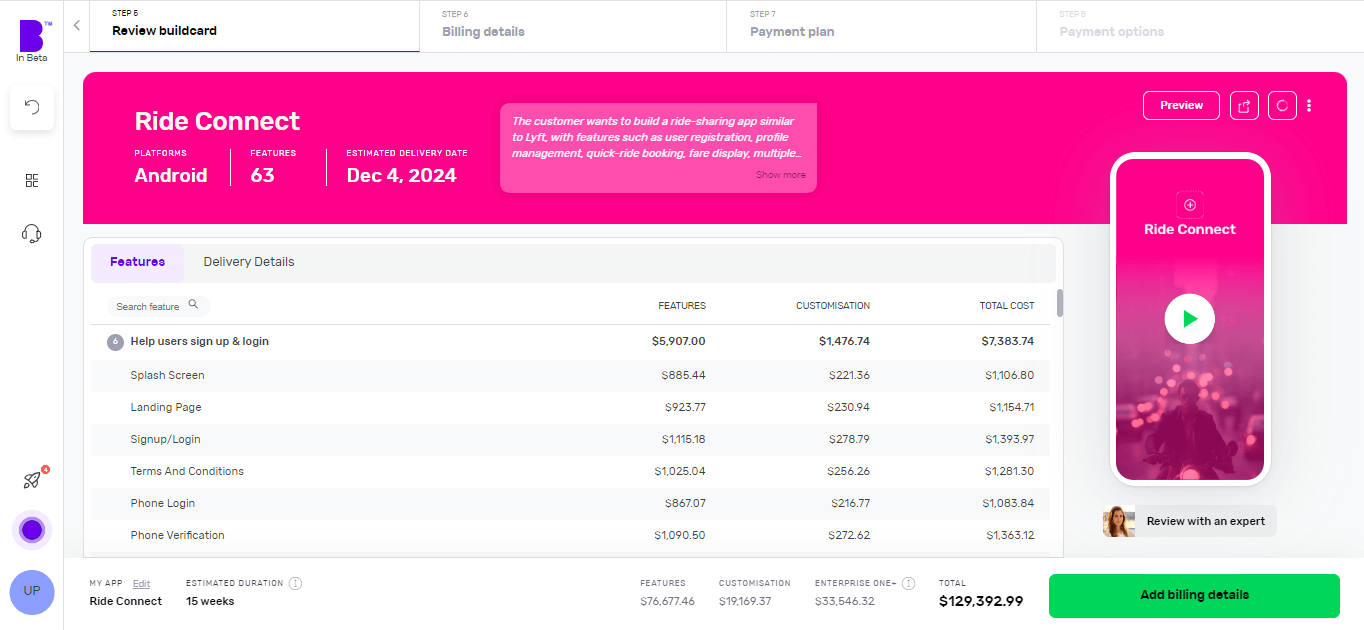
Buildcard provides you with a bird's eye view of all the selections you made in the previous steps. Here, you can review all the features, cost per feature and delivery details.
You can also download the PDF of Buildcard or invite others to show your team members what you’re building.
If you want to make any changes, simply click on 'Edit Buildcard' under 3 dots in the top-right corner.
If you’re happy with everything, click on 'Add billing details' to go to the next section. Alternatively, if you want to review it with experts, click on 'Review with an expert'.
7 - Select your payment plan
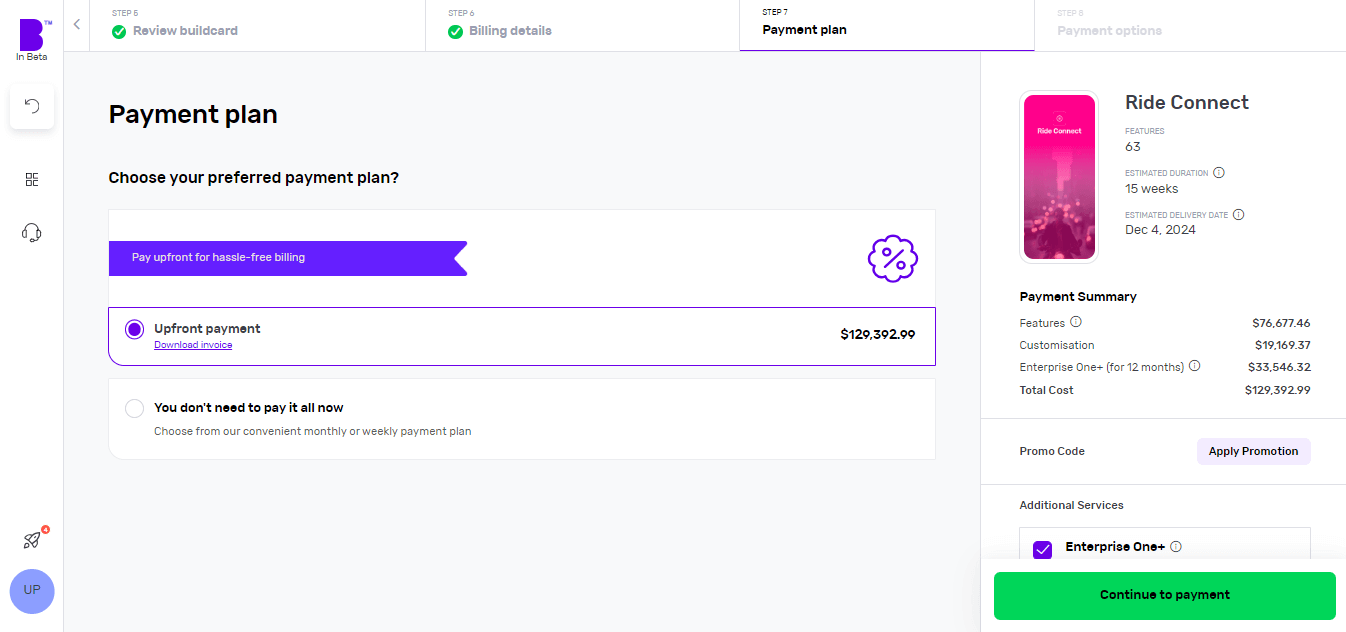
We offer weekly or monthly payment instalments, with visible payment dates and amounts for each option. You can also choose to pay upfront to reduce the cost of your build.
Simply select your preferred billing cycle, then click 'Continue' to proceed.
You’ll be asked to input your payment details and agree to the terms and conditions. Once that’s done, click 'Continue to Payment'.
Once your payment is done, you can set up a meeting with our product managers to begin your app development.
8 - Monitor your app build in real-time
With Builder Home, your real-time project dashboard, you can monitor development progress and make sure your app is exactly the way you want it.
This includes access to a suite of collaboration tools to help improve your app design. You can chat with your team of experts in Builder Meet, brainstorm in Builder Whiteboard and visualise your ideas with free Tailor-made prototypes from Builder Now.
Conclusion
While ride sharing apps like Uber have revolutionised how we travel, they also have their own set of challenges.
Creating your ride sharing app isn't just about entering a competitive market — it's about better serving the diverse needs and preferences of the audience.
With the right features and a user-centric approach, your ride sharing platform can provide a refreshing alternative to the industry giants.
Hit the banner below and kick off your fintech app project with us today 👇
Want to start your app project with us?
Book a demoSpeak with one of our product experts today.
By proceeding you agree to Builder.ai’s privacy policy and terms and conditions

Harsh Priya is a writer at Builder.ai. She has over 3 years of experience in content marketing, spanning across fields like AI, Machine Learning, software, tech, health and lifestyle. With a background in English literature and a fervent passion for research and analysis, Harsh transforms complex concepts into compelling and insightful narratives that educate and drive significant reader engagement.

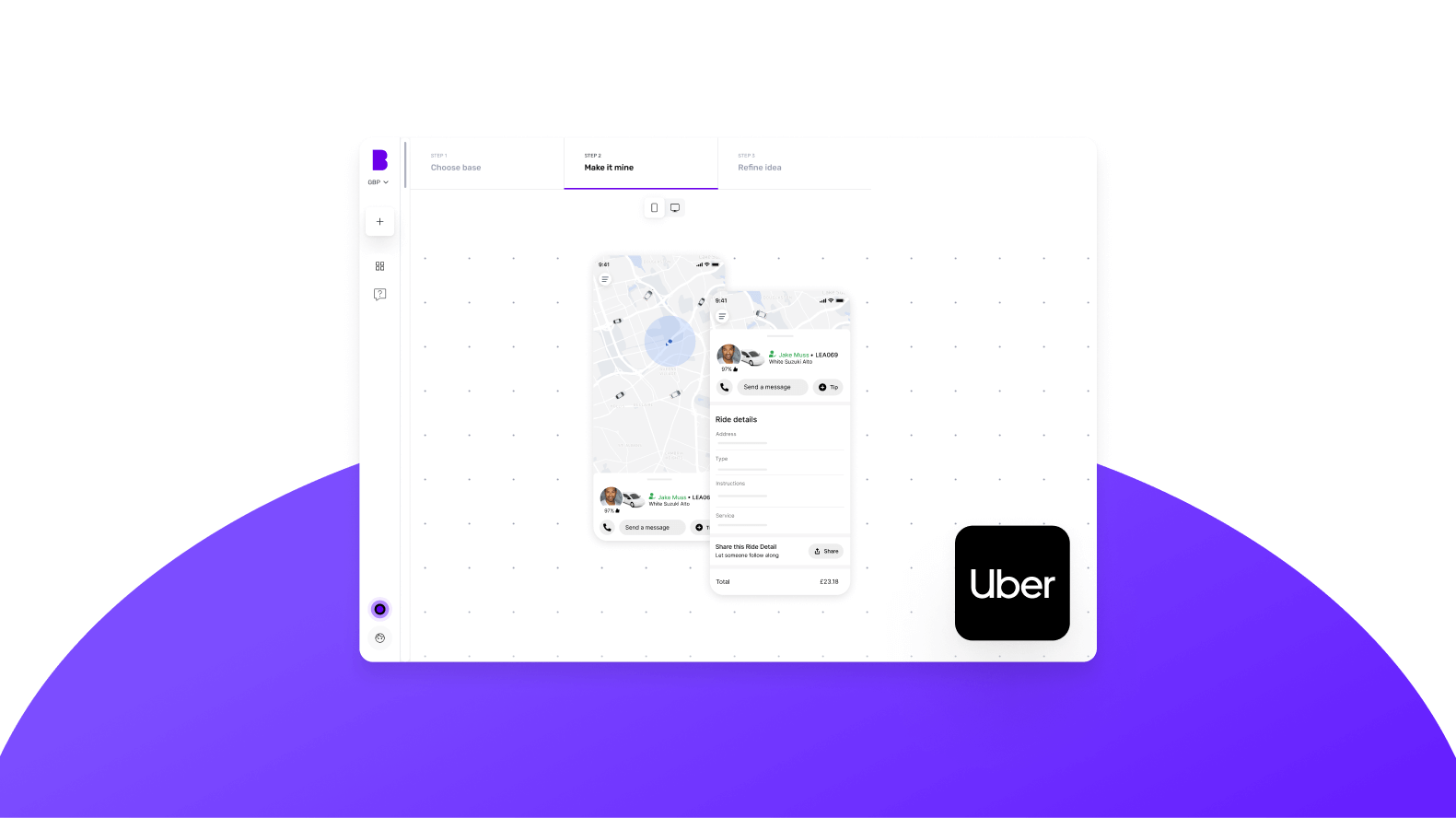








 Facebook
Facebook X
X LinkedIn
LinkedIn YouTube
YouTube Instagram
Instagram RSS
RSS


